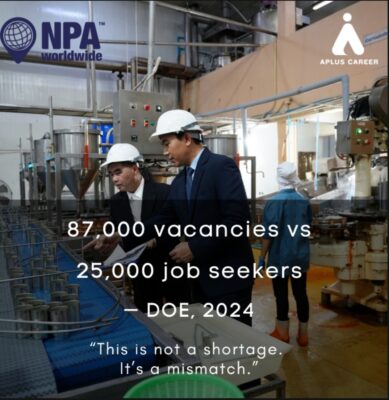Why Thailand’s Manufacturing Sector Is Facing a Talent Bottleneck — And What Leaders Must Do Now By Nina Phinnipha Suriyong Thailand’s manufacturing sector remains one of the country’s economic pillars, yet many factories today face a serious workforce shortage. Employers often say, “We cannot find people,” while many job seekers feel the roles on offer don’t fit their skills or expectations. When you look closely at official labour data, both sides have valid points. Below is a clear, data-supported look at what is happening — and what manufacturing leaders should act on now. 1. What the numbers are showing Official statistics and international research provide a consistent picture: • Around 6.24 million people were employed in Thailand’s manufacturing sector as of December 2024, according to employment data from the Bank of Thailand / CEIC Labour Force Survey. Source: CEIC Data — Manufacturing Employment 2024. • Despite this sizeable workforce, manufacturing output contracted by about 0.5% in 2024, while other non-agricultural sectors held up more strongly. Source: NESDC Quarterly Economic Outlook 2024. • In early 2024, employers reported about 87,000 job vacancies, but only around 25,000 registered job seekers and approximately 16,500 successful placements. Source: Thailand Department of Employment (DOE) — February 2024 Vacancy & Placement Report. • The highest labour demand comes from vocational and diploma-level roles, not bachelor’s graduates. Source: DOE Workforce Demand Breakdown 2024. • Thailand is facing a shrinking working-age population, creating an “acute shortage of skilled labour,” especially in technical fields. Source: RSIS Commentary on Thailand’s Demographic Shift. • Nearly 47.5% of non-agricultural workers still operate in the informal economy. This limits long-term career development and discourages many younger workers from entering factory roles. Source: ILO & NESDC Informal Economy Assessment. • Thailand relies heavily on foreign labour. When around 400,000 Cambodian workers left due to border tensions, industries — especially manufacturing — felt a sudden labour shock. Source: Ministry of Labour updates & regional migration reports. • The ILO’s research on automotive manufacturing shows that digitalisation, EV transition, and automation are raising skill requirements and reshaping job profiles faster than workers can upskill. Source: ILO Studies on Thailand’s Automotive and Manufacturing Workforce. • The BOI has launched a 5-billion-baht upskilling programme aiming to train 100,000 people for advanced manufacturing sectors, signalling the seriousness of the national skills gap. Source: Board of Investment Thailand — Skills Development Initiative 2024. 2. What’s driving the talent bottleneck a) A shrinking, aging workforce Thailand’s working-age population is already declining. The most affected roles are the mid-skill positions — technicians, supervisors, maintenance, and production engineering — which are essential for modern manufacturing. b) Skills mismatch between education and industry There is a strong oversupply of general degrees and a shortage of technical skills such as mechatronics, robotics, industrial automation, and digital quality systems. Many vocational graduates still lack practical, workplace-ready experience. c) Industry 4.0 is moving faster than people can keep up Factories are upgrading equipment — robotics, MES, EV systems — but many workers were trained on older production methods. Without structured upskilling, companies end up believing “no one fits the job,” even though the right people may already be inside their plant. d) Work conditions still discourage young talent Informal contracts, heavy overtime, shift instability, and unclear career paths push many young workers to choose logistics, retail, or service roles instead of factory work. e) Dependency on migrant workers without long-term planning Factories rely on migrant workers for key production roles. But when policy shifts or geopolitical issues occur, labour supply can drop overnight — exactly what happened with recent departures from Cambodia. 3. What leaders should do now 1) Link your workforce plan to your technology plan Automation without a talent strategy always leads to shortages. Before investing in machines, map: • expected new roles • required competencies • internal people who can be upskilled • positions that must be recruited externally This should be a 3–5-year plan, not an annual HR cycle. 2) Build real training ecosystems inside your organisation Short courses won’t solve the gap. Companies need: • internal academies • partnerships with vocational institutes • work–study programmes • training linked to promotions and certification With BOI funding available, this is the right moment to raise training quality. 3) Improve the value proposition for frontline talent Workers stay where they see stability and growth. That means: • transparent career ladders • predictable shifts • supportive supervisors • basic but meaningful benefits like transport, meals, health coverage If the job is well-designed, people stay even if pay is average. 4) Use wider talent pools Manufacturing must diversify its labour sources, including: • women in technical roles • experienced older workers • career switchers from other sectors This increases supply without lowering standards. 5) Professionalise migrant workforce management Instead of treating migrant labour as a quick fix, companies should: • partner with ethical recruiters • provide proper onboarding • offer language and safety training • support migrants through their first 90 days Retention improves significantly when migrant workers feel supported. 6) Collaborate as an industry, not as individual factories Industrial estates, chambers, and associations should: • co-design technical standards • build shared training centres • share talent pipelines • work with the government to accelerate skill reforms Thailand cannot solve its talent bottleneck plant by plant — it requires coordinated action. 4. The bottom line Thailand’s manufacturing talent bottleneck is not a temporary issue. It is the result of long-term demographic change, skills mismatch, uneven training systems, and unstable labour supply. But companies are not powerless. Research consistently shows that organisations investing in automation plus skills development end up with stronger teams and better productivity — not less employment. Today’s critical question for manufacturing leaders is not: “Where do we find people?” but: “How do we become the workplace where skilled Thai and migrant workers want to stay and grow?” About Nina Phinnipha Suriyong With over 15 years in executive search, Nina has placed top talent across industries like manufacturing, automotive, electronics, chemical, retail, and life sciences. She founded APlus Career Recruitment Co., Ltd. in 2022, a boutique agency specializing in recruitment and HR solutions. Looking for your next career move? Contact us today.
